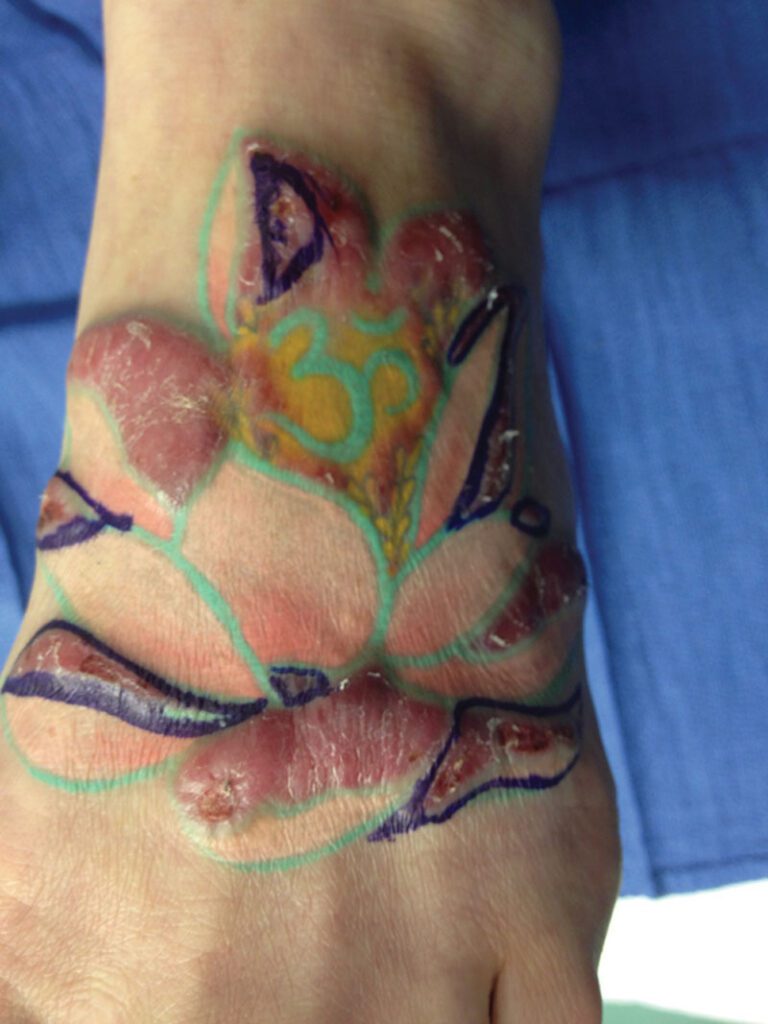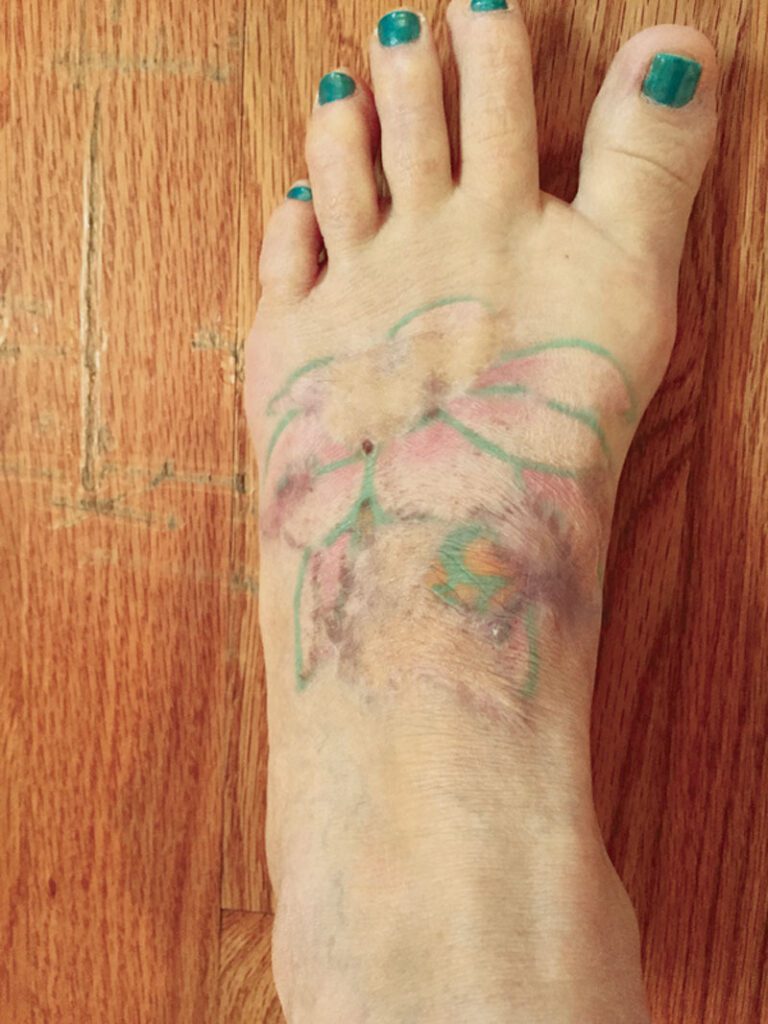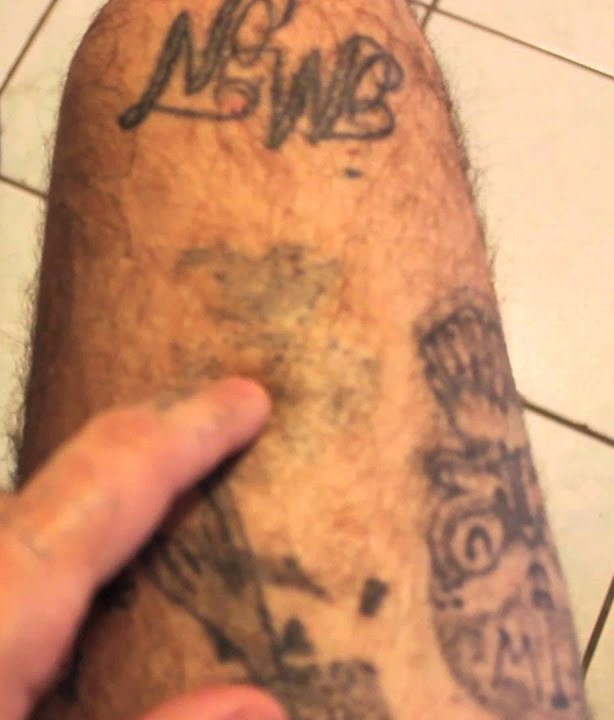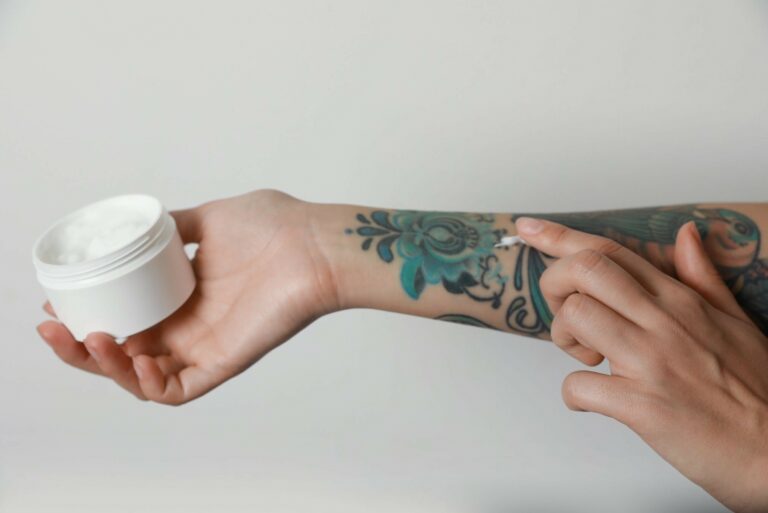Invasive Tattoo Removal Techniques: A Comprehensive Guide
Introduction
Tattoos have been a popular form of body art for centuries. However, with the rise in popularity of tattoos, there has been an increase in the demand for tattoo removal.
While traditional methods, such as laser removal and creams, exist to remove tattoos, they do have their limitations. Invasive tattoo removal techniques are now gaining popularity as an alternative solution.
Explanation of the Rise in Popularity of Tattoos and Subsequent Increase in Demand for Tattoo Removal
Tattoos have become more mainstream over recent years. Celebrities flaunting their inked bodies on social media platforms like Instagram or Twitter are a testament to this. As a result, people from all walks of life feel more comfortable getting tattoos themselves.
However, once someone gets a tattoo that they later regret or want to change for some reason – such as a breakup or wanting better career opportunities – they require a way to remove it safely and effectively. This has led to an increase in demand for tattoo removal services.
Overview of Traditional Tattoo Removal Methods and Their Limitations
Traditional tattoo removal techniques include laser therapy, cryotherapy (freezing), chemical peels, and skin abrasion using salt scrubs or microdermabrasion machines. While these methods can work well on some tattoos, their effectiveness depends on various factors such as the location and age of the tattoo.
Laser therapy is commonly used but it can be expensive and requires multiple sessions to achieve desired results. Moreover, laser treatments can cause scarring or other skin damage if not performed correctly.
Introduction to Invasive Tattoo Removal Techniques as a Potential Solution
Invasive tattoo removal procedures involve surgical excision (cutting out the inked skin tissue), dermabrasion (scraping off the top layers of skin), and salabrasion (a mixture of saltwater and abrasion). These techniques have been gaining popularity because they are more effective than traditional methods and can remove tattoos in a single session. However, invasive techniques are not without risk.
They can cause complications like infection, scarring, and hyperpigmentation. As such, it is essential to research thoroughly and consult with a qualified practitioner before deciding on an invasive tattoo removal method.
As tattoos become more popular among the general population, so does the need for safe and effective tattoo removal techniques. While traditional methods exist, they may not work for everyone.
Invasive tattoo removal procedures are becoming increasingly popular due to their efficacy in removing tattoos quickly in one session. However, there are possible risks associated with these procedures that should be considered before making a decision.
Invasive Tattoo Removal Techniques: An Overview
Tattoos have become increasingly popular over the years, but so has the demand for their removal. While traditional tattoo removal methods such as laser treatment and topical creams can be effective, they are not always successful for all types of tattoos.
This is where invasive tattoo removal techniques come in. Invasive tattoo removal involves physically removing the tattoo from the skin through surgical and non-surgical procedures.
These techniques are more aggressive than traditional methods and may require a longer recovery period. However, they also offer a higher chance of complete removal.
Types of Invasive Tattoo Removal Techniques
There are several different types of invasive tattoo removal techniques available, each with its own set of advantages and disadvantages:
Surgical Excision
Surgical excision involves cutting out the tattooed skin and stitching the remaining skin back together. This technique is best suited for smaller tattoos and those located on flat areas of the body. The procedure can be done under local anesthesia, although larger tattoos may require general anesthesia.
The biggest advantage of surgical excision is that it offers immediate results with a high success rate. However, it can leave behind noticeable scarring.
Dermabrasion
Dermabrasion involves using a high-speed rotary device to remove layers of skin until the tattoo is gone or significantly faded. This technique works well on large tattoos or those located on curved areas of the body such as arms or legs but may not be as effective for tattoos on bony areas like ankles or fingers. Dermabrasion requires local anesthesia to minimize pain during the procedure, but multiple sessions may be required to fully remove a tattoo completely.
Salabrasion
Salabrasion involves using a saltwater solution to break down the ink particles in the skin, which are then removed through scrubbing with a saltwater-soaked pad. This technique is best suited for those who are looking for a less invasive option that doesn’t require anesthesia or extensive recovery time. However, salabrasion is not as effective on darker colors and may require multiple sessions to see results.
While invasive tattoo removal techniques offer a higher chance of complete removal, they do come with some risks and potential complications. It’s important to discuss all options with a qualified healthcare provider to determine which technique is best suited for you based on the size, location, and color of your tattoo as well as other medical considerations.
Surgical Excision: The Aggressive Approach for Tattoo Removal
Surgical excision is a highly invasive tattoo removal technique that entails the complete removal of the tattooed skin. This procedure involves cutting the skin around and beneath the tattoo to remove it completely.
During surgical excision, a local anesthetic is used to numb the area around the tattoo. Once numb, an incision is made around the outer edges of the tattoo, and then a scalpel is used to carefully lift and remove the skin beneath it.


The wound created during this process is then stitched up using sutures or stitches. This method of tattoo removal works best for small tattoos.
Large tattoos may require multiple procedures, which can be quite expensive and time-consuming. Individuals with darker skin tones may also experience more significant scarring than those with lighter skin tones.
Size Matters: Choosing Which Tattoos Are Suitable for Surgical Excision
Due to its highly invasive nature, surgical excision should only be considered for small tattoos that are less than 4 inches in diameter. Larger tattoos require longer incisions which may take longer to heal, making them more susceptible to scarring and infection. It’s important to note that certain areas of the body such as fingers, hands, feet, and ankles may not be suitable for this type of procedure due to their high risk of infection.
Risks and Complications Associated with Surgical Excision
As with any surgical procedure, there are potential risks and complications associated with surgical excision. These include but are not limited to:
– Infection – Excessive bleeding
– Pain – Scarring
– Poor wound healing To reduce these risks it’s crucial that patients follow all post-operative instructions given by their healthcare provider including keeping dressings clean and dry between appointments.
Dermabrasion: A Deep Exfoliation for Tattoo Removal
Dermabrasion is a technique that uses a specialized tool to mechanically exfoliate the skin’s surface layers. In tattoo removal, it involves using a high-speed rotary device with an abrasive brush or diamond wheel to “sand down” the skin, removing the layers where the ink resides.
The procedure can be performed under local anesthesia and is typically done in multiple sessions. Dermabrasion is most effective for removing small tattoos and those that are not too deep below the skin’s surface.
The technique works best on black or dark-colored tattoos as they absorb more light and heat, making them easier to break down. However, it may not be as effective on light-colored tattoos or those that use white ink.
As with any invasive procedure, dermabrasion does carry some risks and potential complications. Common side effects include redness, swelling, bruising, and scabbing in the treated area.
In some cases, scarring or changes in skin texture may occur. It is important to follow aftercare instructions carefully to reduce the risk of infection and ensure proper healing.
Is Dermabrasion Right for Your Tattoo Removal?
The effectiveness of dermabrasion will depend on various factors such as the size and location of your tattoo, your skin type/color, and your overall health. Small tattoos located on areas with thinner skin (e.g., wrists) tend to respond well to dermabrasion compared to larger ones situated over thicker areas (e.g., back).
It is also important to note that dermabrasion can be painful since it involves removing layers of skin with an abrasive tool. While local anesthesia can help alleviate discomfort during the procedure, you may experience some pain during recovery.
If you have sensitive skin or a history of allergic reactions or infections after previous treatments/procedures involving your skin, you may not be a good candidate for dermabrasion. It is essential to discuss your medical history with your dermatologist or tattoo removal specialist before undergoing any invasive procedure.
The Bottom Line on Dermabrasion for Tattoo Removal
Dermabrasion is a viable option for those looking to remove small tattoos that are not too deep and located in areas with thinner skin. While it does carry some risks, the potential side effects can be minimized by following proper aftercare instructions and working with an experienced specialist. If you’re considering tattoo removal via dermabrasion, make sure to consult with a qualified professional who can assess your suitability and provide a tailored treatment plan.
Abrasive Power: Salabrasion Tattoo Removal
Salabrasion is a technique that involves using salt to remove a tattoo. While this method may sound strange, it has been used for centuries and can be effective in removing tattoos.
The idea behind this technique is that the salt will help to break down the ink particles in the skin, which will allow them to be absorbed by the body. The process of salabrasion involves rubbing salt onto the skin and then using an abrasive device, such as a sponge or sandpaper, to scrub away at the tattooed area.
This process can be painful and may take several sessions to completely remove a tattoo. Salabrasion is generally considered to be less effective than other invasive techniques, but it can be a good option for certain types of tattoos.
Type and Size of Tattoos
Salabrasion is most effective on small tattoos that are located on areas of the body with thick skin, such as the arms or legs. It may not be suitable for larger tattoos or those located on more sensitive areas of the body like fingers or face.
The effectiveness of salabrasion also depends on factors such as the type of ink used in the tattoo and how deeply it was injected into the skin. Professional tattoos that use high-quality ink tend to be more difficult to remove than amateur tattoos done with lower quality ink.
Risks and Complications
Like all invasive techniques, there are risks associated with salabrasion. One significant risk is infection due to open wounds created during each session. The abrasive action of salting and rubbing off layers can also cause intense pain and discomfort during treatment sessions.
In addition, there is always a risk that scarring will occur during or after treatment due to abrasions – particularly if patients do not follow aftercare instructions exactly as prescribed by their physician. Scarring may also be more noticeable on people with darker skin tones, as the abrasions tend to leave lighter-colored blotches or patches.
Overall, salabrasion can be an effective option for some patients seeking tattoo removal. However, it is important to weigh the risks and benefits carefully before deciding on this method and to consult with a qualified physician who specializes in tattoo removal to determine whether salabrasion is the right choice for you.
Comparison between Invasive Techniques & Traditional Methods
The Advantages of Invasive Techniques
In comparison to traditional tattoo removal methods, invasive techniques have a number of advantages. Firstly, these methods are much more effective in completely removing tattoos. While traditional methods such as laser treatment can fade a tattoo to some extent, it may not be possible to remove it completely.
In contrast, invasive techniques can completely remove even the most stubborn tattoos. Secondly, invasive techniques are generally faster than traditional methods.
For example, surgical excision may only require one session compared to several sessions of laser treatment for the same area. Invasive techniques tend to be less painful overall than traditional methods such as laser treatment.
The Advantages of Traditional Methods
Despite the advantages that invasive techniques offer over traditional methods of tattoo removal, there are still situations where traditional methods may be preferable. One major advantage is that they are much less invasive and carry fewer risks than surgical or dermabrasion procedures. Additionally, traditional laser and light-based treatments do not cause any scarring in most cases and have minimal downtime compared to surgeries that require significant healing time.
Conclusion – Which Method Is Best?
Ultimately, the choice between an invasive technique and a non-invasive method will depend on the individual circumstances of each person seeking tattoo removal services. Factors like skin type and coloration at the site of the tattoo need consideration before choosing a method that works best for each situation. While both types have their strengths and weaknesses, it is useful to remember that these procedures should always be performed by licensed professionals with plenty of experience in order to minimize risks and ensure optimal results regardless of the chosen method.
references
Salabrasion
Laser Tattoo Removal: A Clinical Update – PMC (nih.gov)
Tattoo Removal—A New Simple Technique – PMC (nih.gov)
Surgical excision
Mini-Punch Skin Excision: A Newer Novel Approach for Tattoo Removal – PubMed (nih.gov)
Systemic Allergic Reaction to Red Tattoo Ink Requiring Excision – PubMed (nih.gov)
Dermabrasion
Medical Complications of Tattoos: A Comprehensive Review – PubMed (nih.gov)
Non-laser treatment for tattoo removal – PubMed (nih.gov)
Superficial dermabrasion – PubMed (nih.gov)
Tattoo removal by CO laser dermabrasion – PubMed (nih.gov)
Medical Disclaimer:
The information provided on this website regarding tattoo removal techniques is for general informational purposes only. It is not intended to be a substitute for professional medical advice, diagnosis, or treatment. Always seek the advice of a qualified healthcare professional regarding any medical condition or concerns, including tattoo removal.
The content presented on this website should not be interpreted as endorsing or promoting any specific tattoo removal technique, product, or service. The effectiveness, safety, and suitability of tattoo removal methods can vary depending on individual circumstances and factors. Therefore, it is crucial to consult with a medical professional or qualified specialist before making any decisions or embarking on any tattoo removal procedure.
The website does not guarantee the accuracy, completeness, or reliability of the information provided. Reliance on any information from this website is solely at your own risk. The website and its owners, authors, and contributors shall not be held liable for any damages or consequences arising from the use of the information provided.
It is important to note that medical practices and standards may change over time, and the information provided on this website may not always reflect the most up-to-date research or guidelines. Therefore, it is recommended to consult with healthcare professionals or reputable sources for the latest information and advice on tattoo removal techniques.
If you experience any adverse reactions, complications, or concerns during or after a tattoo removal procedure, promptly seek medical attention. Only a qualified healthcare professional can assess your specific situation and provide appropriate advice and treatment.
By using this website, you acknowledge and agree to the above disclaimer, and you understand that the website and its owners, authors, and contributors cannot be held responsible for any decisions or actions taken based on the information provided.


